Typical sallet or atypical sallet: continuation of the exhibition of "iron"
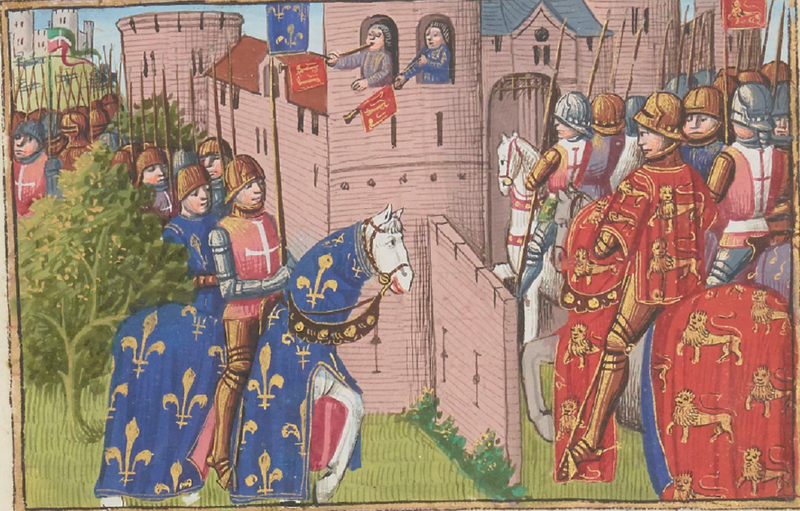
"The British are driving the enemy out of Bordeaux." Unknown artist. Martial of Auvergne. "Vigilia on the Death of King Charles VII". OK. 1477-1484 National Library of France, Paris
The book of the prophet Jeremiah, 46:4
stories about weapons. Middle Ages. The publication on VO one after the other of two materials about helmets, and first on miniatures from manuscripts, and then artifacts from museums, aroused great interest among readers. In their comments, they placed photographs of an English helmet, and a “helmet of Hadrian” with a star, and a photo of a typical medieval salad. And today we will continue the theme of medieval weapons, but we will somewhat change, so to speak, its vector. Consider the "typical" and "exclusive" in the armor of those distant days.
Today we are used to the fact that there is a certain set of uniforms and protective equipment. And let someone "a little less" or "a little more" does not really matter. Armies in the millions! However, even today, many “servicemen” acquire both shoes and uniforms for themselves, because the price of it and the price of their own lives are incomparable things. And if now the life of every soldier is becoming more expensive every day, then ... at that time such a trend also existed, although it did not concern everyone. But only warriors ... of noble blood. And it is clear why: "noble blood" was the key to social significance and responsibility. In fact, all the knights of the Middle Ages, translated into today's titles, would have been governors of regions, mayors of cities, heads of village councils, directors of factories. On their necks “hung” counties and principalities, one, two, three or more castles, villages full of peasants, roads and bridges, monasteries where the Lord God prayed for them, court and execution - all this was in their hands. And you also had to fight, and thereby expose your truly priceless life to danger. So they dressed in iron so that enemy weapons would not reach them. To kill ourselves, but not to be killed.
That is, almost all knightly weapons were made to order. And if the “knight of one shield” or a small-scale baron could still condescend to allow himself to come to the master and allow him to take measurements from him, then noble gentlemen sent instead of themselves or servants of the appropriate complexion, or their clothes, or ... carved from wood figures on which the masters worked. And for fitting the armor was again taken to the court. Not every prince-sovereign was ready, again, to go somewhere there to another city, or even a country, even to a famous, but still a master. It was then that the Emperor of the Holy Roman Empire, Charles V, did not hesitate to raise his brush to Titian. During the High Middle Ages, this would hardly have been possible.
And just as we now define shoes from Prado and suits from Cartier, so at that time, according to the details of the armor, the corrugation of surfaces, the bends and the processing of the edges - just like today, according to the cut of a good suit - experts could tell where and even by whom made this or that armor or helmet.
So the use of “white armor”, in which the knights, like clothes, were dressed from head to toe, led to the fact that by the middle of the XNUMXth century, two schools and two centers of their production had developed in Europe. The first is in Northern Italy, in Milan, and the second is in the Augsburg area in Northern Germany. And how many purely local industries existed, and do not count. And they all made armor, some better, some worse, some worked cheap lots, and some boasted of orders from dukes and kings.
Moreover, the knights, if they were rich enough, could even invite a very famous gunsmith to their place. Or they could buy armor from visiting merchants who bought up "iron" right at the sites of major battles, repaired beaten and mangled and ... sold as the newest and most fashionable. So, however, they do with cars today ...
The third option, as already noted, was a wax or wood model from the torso and limbs; it was sent to the master, and he already customized the armor he had at the level of "consumer goods" under it. For example, in a letter dated March 16, 1520, King Francis I of France asks to send him a "duplicate for armor" of Henry VIII of England in order to order a cuirass from him as a gift to the King of England.
And then this: the Italian armor was more “chubby”, smoothed out outlines, but the German ones, on the contrary, were called Gothic because their outlines looked like lancet, Gothic buildings decorated with turrets. It was later that this term “glued” to all “white armor” of the 1500th century, and the Gothic style in armor itself existed in Germany until about XNUMX, and then they also moved away from it.
It is also important to note that all the armor of the XV century is extremely functional. There is nothing superfluous in them, there are no decorations. Although there have always been "avant-garde". So, in 1410, the English knight John de Fearles paid the Burgundian gunsmiths 1727 pounds sterling for armor, a sword and a dagger, which he ordered to decorate with diamonds and pearls: at that time, a luxury unheard of and even excessive for later times. Moreover, it is interesting that for the same English - both noble lords and small estate gentry, for a long time it was customary to order armor from the masters of continental Europe. They did not set their own high.
And it was from Europe to England that the sallet helmet, or chalet, or selle, or sallet came.
Naturally, such a "division of labor" led to an active search for new forms of the same helmets in the first half of the 1407th century. The same salad appeared in Italy (“selata”) in 1420. Then there were France and Burgundy, and by 1429 the helmet reached Germany and England. And the battle of Patay was in XNUMX, that is, there was more than enough time for this helmet to be on the head of the Duke of Talbot, who commanded there. And it was with him that a frame from the film "Joan of Arc" by Luc Besson was on the screen saver of one of the previous materials about helmets.
The main thing here is national differences - the presence of a long tail on German helmets, while the French and Italian ones looked like a bell. Around 1490, a "black sallet" appeared, either dyed or covered with fabric), with a forearm protruding forward at an acute angle. At the same time, salads appeared with an "accordion" visor, which no longer looked so much like a salad, but like an armet helmet.
By the way, Liliana and Fred Funken in their "Encyclopedia of weapons and military costume" give as many as 16 options for a sallet helmet, while there are only 6 of the same barbut. lettuce" in France. Equipped with a visor, it was called a “bascinet with a snout”, so there was a lot of confusion among specialists, right up to the Tower of London. But let's now look at these helmets in hardware. After all, it is better to see once than many times ... to read.
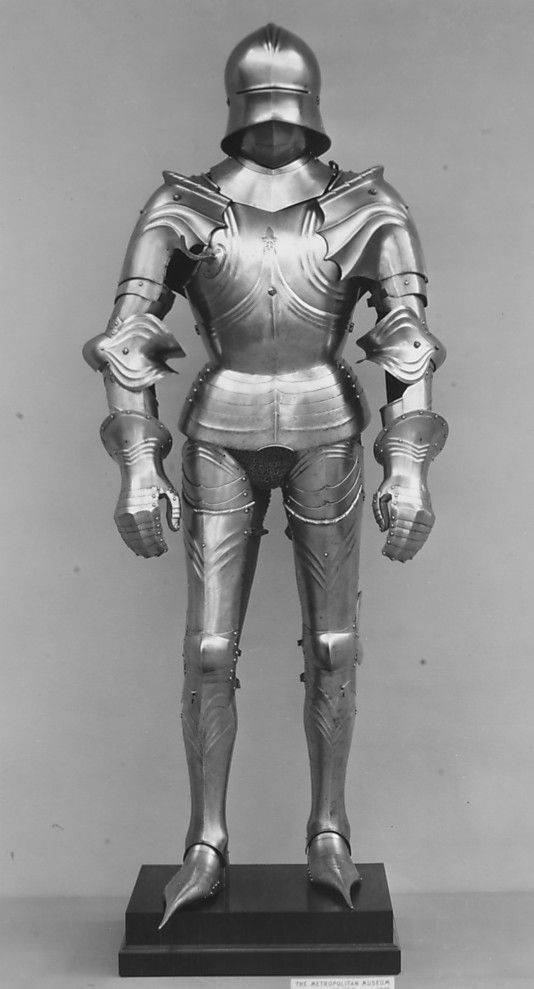
Classic knightly armor, which was most often discussed in textbooks for schools and universities. Before us is Italian armor of the 170,2th century, restored in the 26,1th century. Height 2850 cm. Weight XNUMX kg. Helmet weight XNUMX Metropolitan Museum of Art, New York
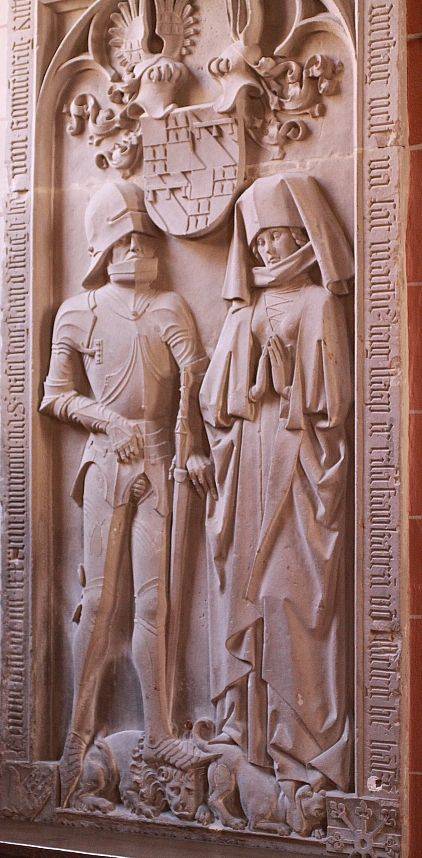
Effigia of Johan VI von Kronberg, c. 1488 A knight in typical Gothic armor with a bouvier chin and a sallet (salet) helmet. Church of the city of Kronberg, Germany
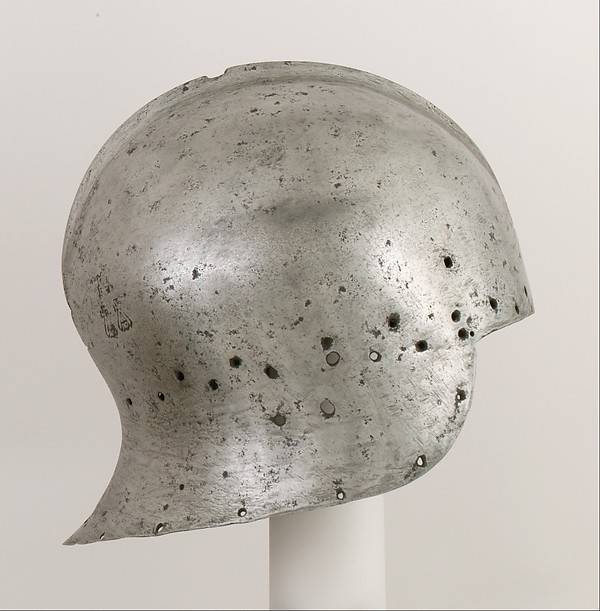
The simplest helmet is a sallet or sallet, which differs from a servillier only in that it has a back-plate. Milan, 1470-1480 Weight 1625 Metropolitan Museum of Art, New York
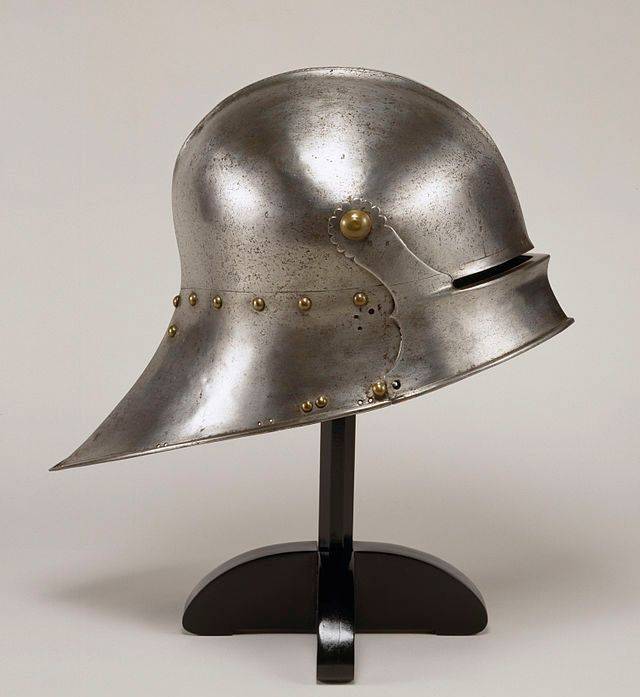
German version of sallet with visor. Walters Museum, Baltimore
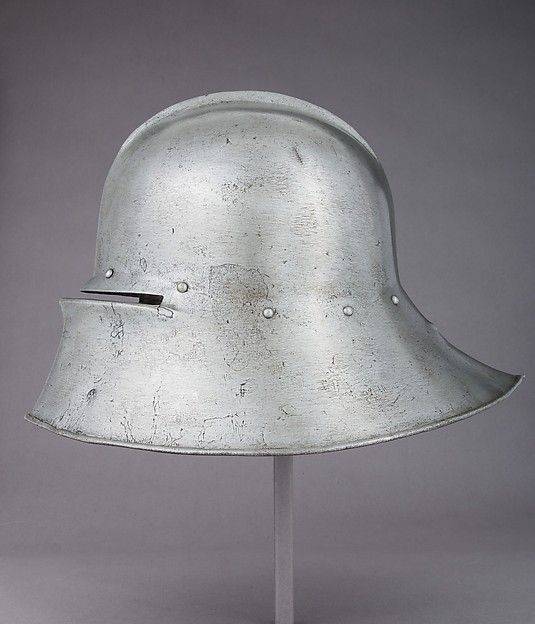
Salad bell, 1480 Germany. Weight 3416,1 g. Such helmets were mainly worn by foot soldiers. Metropolitan Museum of Art, New York
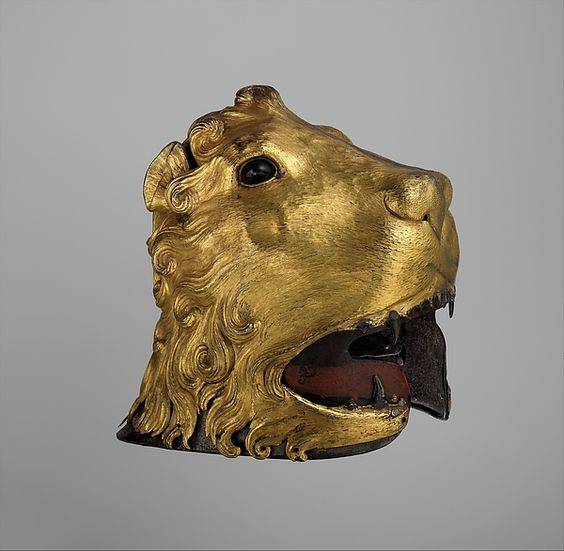
Completely unique, unlike anything else, Lion's Head Salad. 1475-1480 Italy. Steel, copper, gold, glass, textiles. Metropolitan Museum of Art, New York
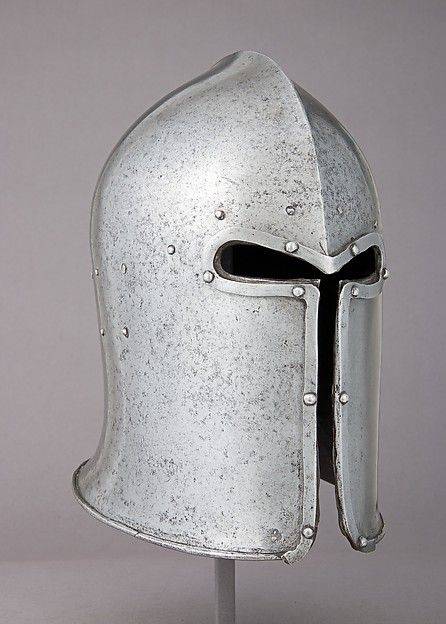
Barbute master Bernardino da Carnago, Italy, Milan, c. 1475 Weight 2948 Metropolitan Museum of Art, New York
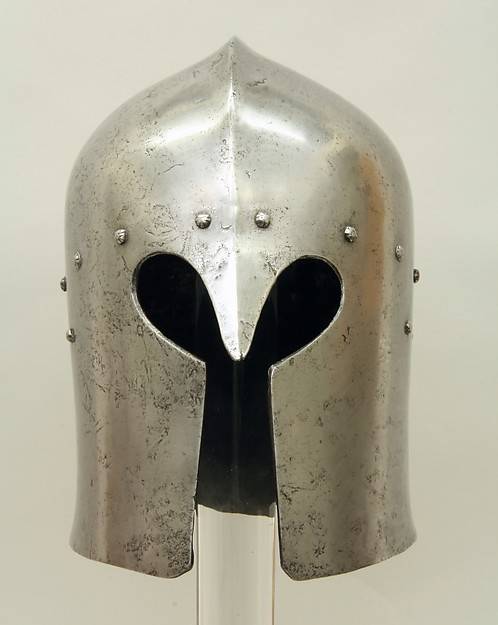
Barbute master Pietro da Castello, Italy, Brescia, 1470-1480. Weight 2211 Metropolitan Museum of Art, New York
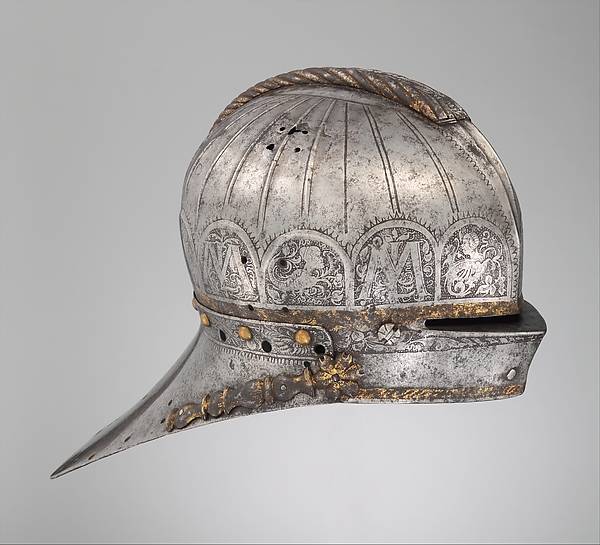
Sallet helmets were used not only in battles, but also in tournaments. Here, for example, is the tournament salad of Louis II (1506 - 1526), King of Hungary and Bohemia. Germany, Augsburg, 1525 Augsburg. Weight 4082 Metropolitan Museum of Art, New York
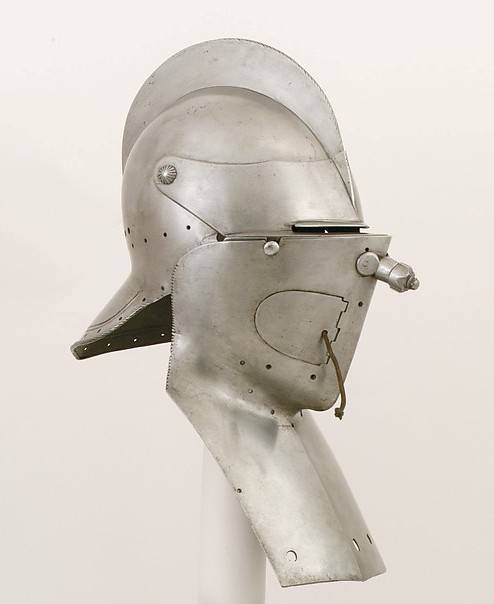
German tournament sallet with a buff for equestrian duel with spears. Weight 4,598 kg. Around 1570-1600 Pay attention to the door with a cord that needed to be pulled to open it for ventilation. The screw in the center of the buff served to connect to the helmet. Metropolitan Museum, New York
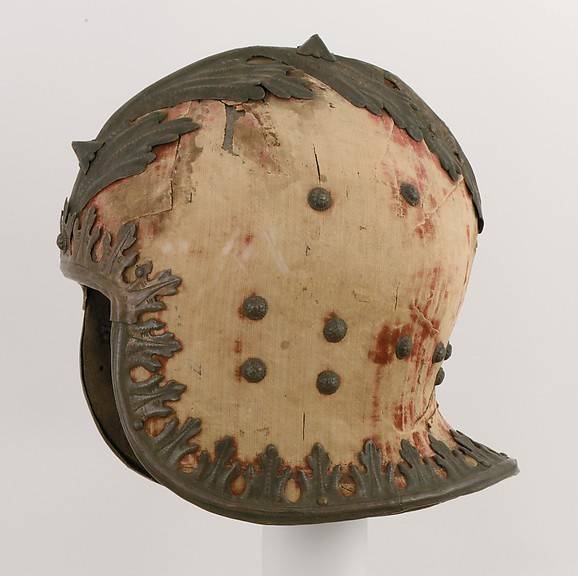
Sallet in Venetian style, upholstered in fabric. Metropolitan Museum, New York
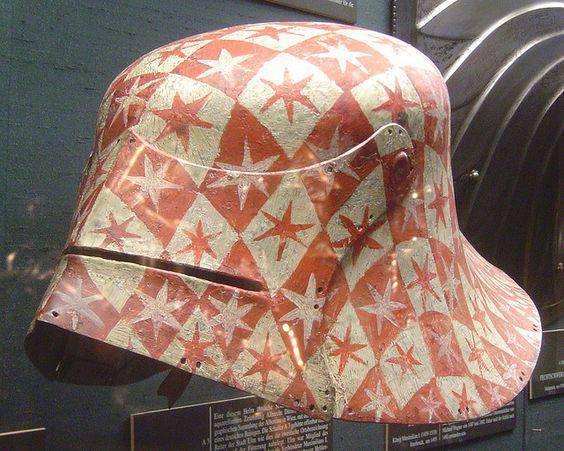
Typical "black salad" (but painted!), 1490-1500. Southern Germany. Imperial Armory (Hofburg, New Castle, Hall I). Author's photo
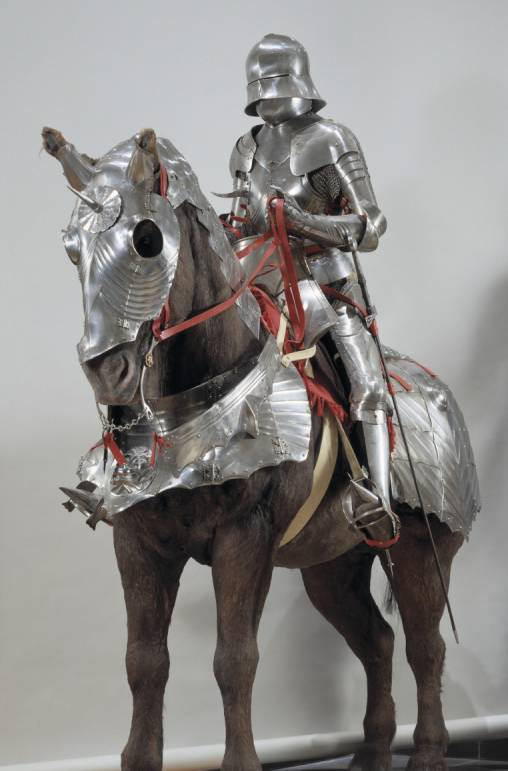
German Gothic all-metal armor of the late 1450th century. Horse armor was made for Duke Voldemar VI of Anhalt-Zerbsky (1508–XNUMX). Royal Arsenal, Leeds
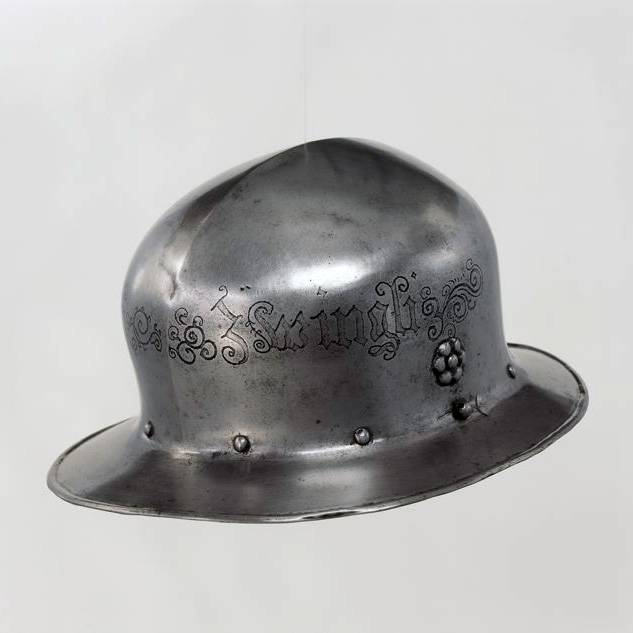
Helmet "chapelle de fer" - "iron hat", 1500-1535. Weight 925 Swiss National Museum, Zurich
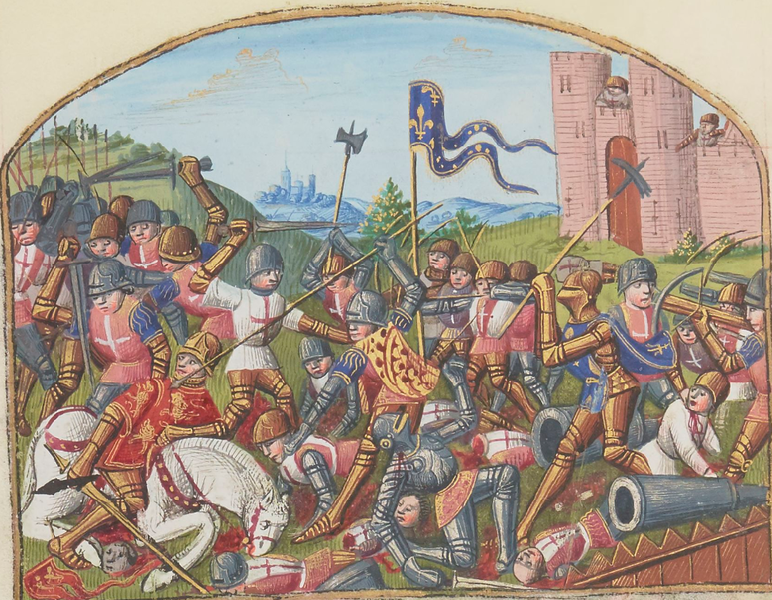
"The last battle of the Hundred Years' War - the battle of Castillon on June 17, 1453." Unknown artist. The death of the English Marshal Duke Talbot is shown (at that moment he was about 80 years old!), Who dressed up in a red velvet surcoat for this battle. Moreover, he himself is wearing a sallet helmet, and the warrior who kills him with a spear is also wearing a sallet! Martial of Auvergne. "Vigilia on the Death of King Charles VII". OK. 1477-1484 National Library of France, Paris
Information